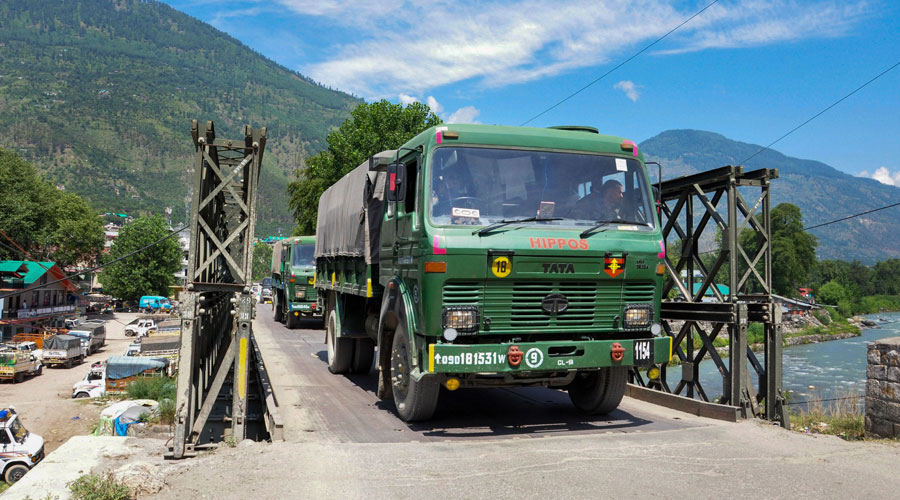Chinese troops are believed to have moved back slightly from the June 15 face-off site in the Galwan Valley and removed some temporary structures and tents, Indian government sources said on Monday.
The sources described this as the first sign of mutual disengagement by the two armies after two months of standoff along the Line of Actual Control (LAC).
There was no official word from either the government or the Indian Army about the exact specifications of the mutual disengagement even though unnamed government sources hailed it as a breakthrough.
In response to the question whether China had moved back equipment in the Galwan Valley, Chinese foreign ministry spokesperson Zhao Lijian said in Beijing that both sides were “taking effective measures to disengage and ease the situation on the border”.
The Indian government sources said both sides had agreed to a mutual disengagement from Patrolling Point 14 (PP14), the clash site where 20 Indian soldiers were killed. The Chinese troops are believed to have pulled back 1km from the clash site, creating a buffer zone between the two armies, the sources added.
The sources said some pullback had taken place in the Gogra-Hot Springs friction point, too. But Chinese heavy armoured vehicles “are still present in the rear and depth areas in Galwan River area”, one of the sources said. There has been no pullback in the Pangong Lake area, they added.
At night, an Indian defence ministry official said: “They are still very much present in Indian territory in the Galwan Valley over which they have claimed sovereignty. It need not be called disengagement at this stage as it is nothing substantive yet. As of now, this is just a minor pullback from the face-off site.”
The official said the Chinese move was being viewed as a reflection of the country’s longstanding policy of “two steps forward, one step backward”. He suggested that only a thorough survey would establish whether the “pullback” had been executed in such a way that it left China with an area larger than was in its possession before the stand-off began.
“Seeing is believing. Physical verification is needed and we are watching closely if this is genuine,” the official said.
An Intelligence Bureau official had said earlier in the day that the pullback may have been necessitated by the heavy flow in the Galwan River caused by melting snow. The water level is making it difficult for either army to sustain its troop build-up in the area, the official had said.
“The river flow has been affecting positions on both sides and the Chinese are reported to have removed their structures from the river-bend embankment. The latest move may also be linked to the harsh terrain,” the official said.
The unnamed Indian sources credited the development to the intense military-level and diplomatic-channel talks between the two sides over the past seven weeks and also linked it to Prime Minister Narendra Modi’s Ladakh visit on Friday.
A military veteran asked: “Does it mean that India will pull back further into its own area in the Galwan Valley and China will move back from the areas it has intruded into by a kilometre or so but will still hold on to areas inside India’s claim line? Why is there no joint statement from the two sides with specific details of the disengagement, backed by satellite images, if it is such a big breakthrough?”
Colonel Ajai Shukla, a veteran, tweeted: “There are ‘govt official says’ reports of Chinese ‘pullback’ from PP14 clash site in Galwan. Great, if true, but am waiting to see: (a) Official govt statement (why anonymous report?) (b) Satellite photo verification of pullback (c) Where have Indian troops pulled back to?”
He added: “There is also the possibility that for technical reasons --- e.g. a rise in water levels of the Galwan River, which fluctuates often -- the Chinese could have relocated their camp; and could well return when the water levels subside.”
Another veteran said: “According to the government sources, both sides have agreed to move back by 1 to 2km. The important question is, 1km from which spot? If they (Chinese troops) have moved back from the face-off site, it means they are still inside India’s claim line. And why are we moving back in our own territory?”
Asked why the government has so far not issued any official statement, a security official said: “Technically, it is difficult to say this is disengagement as of now. The exact distance of the pullback will be known only after 72 hours of physical verification. This could be the main reason behind the government and the army’s restrained response this time.”
Two days before the bloodshed last month, the Indian Army chief had claimed that all was well at the LAC and that a lot of disengagement had taken place.











